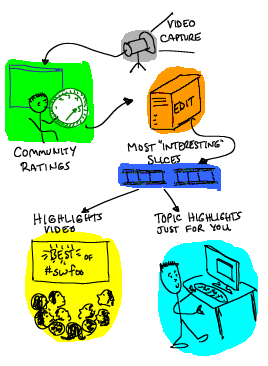 This weekend Friends of O’Reilly invited over about 150 friends for a weekend of conversation and sharing about social networking and related topics. No big agenda, just people talking about “how to change the world.” Attendees included people from Facebook, MySpace, FriendFeed, Twitter, and so on. They called the event Social Web FooCamp 2009 (#swfoo on Twitter).
This weekend Friends of O’Reilly invited over about 150 friends for a weekend of conversation and sharing about social networking and related topics. No big agenda, just people talking about “how to change the world.” Attendees included people from Facebook, MySpace, FriendFeed, Twitter, and so on. They called the event Social Web FooCamp 2009 (#swfoo on Twitter).
Looking through the list of attendees though I don’t see much in terms of video social networks, such as Ustream or YouTube. With better bandwidth, the wider adoption of webcams, and the like, I would have imagined that video would have played a bigger role in the discussion. Maybe there was.
If I’d had a chance to Skype in let alone attend I’d have made the case for a permutation of social video, which I call Community Guided Video Editing.
Here’s the basic idea: First, imagine an open, second-by-second video stream rating and tagging service made available to anyone watching a video anywhere. The service would then archive and aggregate the data to create a collective view of what was being watched. There are lots of things that can be done with the data, but the unique suggestion here is to leverage it to drive a video editing algorithm.
Imagine a service that splices the video into “interesting” segments based on the ratings and tags provided earlier by users and then stitches the sequences together to create a condensed version of the content. Or let’s say there are a series of video streams of a given event, many community recorded and rated using a system such as this. With possibly minimal direct human guidance, a reader’s digest version of the interesting parts of the event could be auto-collected and spliced together. A priori knowledge or adjustments by human editors could be used to guide the process, but for the most part it could be automatic.
Over time, the idea could be taken further. Imagine that the system creates more than one permutation of an edited video which is then rated and ranked by the number of views, etc. See the potential for a feedback loop here? The data could be leveraged to determine which raters provide the most “successful” results–such as the highest rated videos or most watched videos. This breakdown could be by topic, region, category (live, taped), age, or some other criteria. The system could measure, compare, refine.
Anyway, the quality of the ratings and tagging data is important here. Not every user is going to have the same “authority” if you will. And, authority itself, as just outlined might even be dynamic although it would be something that could be overridden at any given time. Humans controlling the service and the algorithms are ultimately the editors here–they essentially are editing indirectly by adjusting the impact of the feedback they get using code rather than direct manipulation. It saves time and opens up some interesting possibilities, such as real-time video stream switching in a live feed (imagine a video editing news crawler that finds and switches between “interesting” live feeds–based on ratings or numbers of viewers, etc–from people broadcasting from a region where there just was a tornado or an earthquake?). Another important aspect of a system like this would be numbers. If you have lots of data, with little noise, it might be easier to narrow in on what’s of most interest. The principle is not all rankings and ratings need to be treated equally compared to each other or over time.
Here’s a scenario: I would have loved to see what was going on at #swfoo. What an ideal place for people to be broadcasting live throughout the event. Given these feeds, now imagine the videos were ranked by numbers of home viewers, duration viewed, and so on as well as user provided second-by-second ratings and tags. Conceivably the system could generate a Reader’s Digest version of the most “interesting” parts of the event based on data from previous viewers. Or with the proper tagging, who knows, it might be possible to create an edited video that covers some topic, let’s say the announcement of product XYZ. The permutations could be quite interesting themselves.

Community guided video editing #swfoo http://tinyurl.com/dka62a
This comment was originally posted on Twitter